24 Hour Museum: From Past to Future
24 Hour Museum [1] is a successful and sustainable cultural Web site. Type the word 'museum' into Google UK and up it pops as a top five search result. Unlike the other top sites, all national museums or galleries, 24HM's remit covers the whole country, in eclectic subject areas, reaching a wide variety of audiences with simple and accessible content.
In 2006 24HM reached ten million visits in the year. 2007 sees the site reaching a million visitors a month, from home to office, schoolroom to museum. Funded by the DCMS through MLA, with additional money from the Department for Education and Science (DfES) and the Arts Council, it is run from small offices in Brighton with a full- and part-time staff of around ten.
Now, as Web 2.0 brings new opportunities for the cultural sector [2][3], 24HM is undergoing a redesign to accommodate the possibilities of the new Web; into this is being added a wider view of the digital cultural landscape, and linkages with the plans and strategies of MLA, Arts Council and also key sector partner MDA [4].
In the Beginning
In May 1999 the 24 Hour Museum was launched to general acclaim [5] and occasional brickbats. It was born into a Web 1.0 world of sites built in clunky and passive HTML, frames and portals: museum Web sites as venue brochures. The heart of the 24HM was a simple dynamically driven Web magazine about museums and galleries, with a database of venues, plus a regional map and some longer themed features dubbed 'trails.'
As the 24HM went live, it created a stir when Culture Secretary Chris Smith bestowed 'National museum' status upon the site [6]. There is, of course, much more to being a National museum than putting up a Web site, and at the launch of the new site to the sector there were some red faces and cross words. But it was a bold vision, the era of free access to museums, and some would say the seeds of bigger plans like Culture Online [7] were sown when 24 Hour Museum opened its digital doors for virtual visitors.
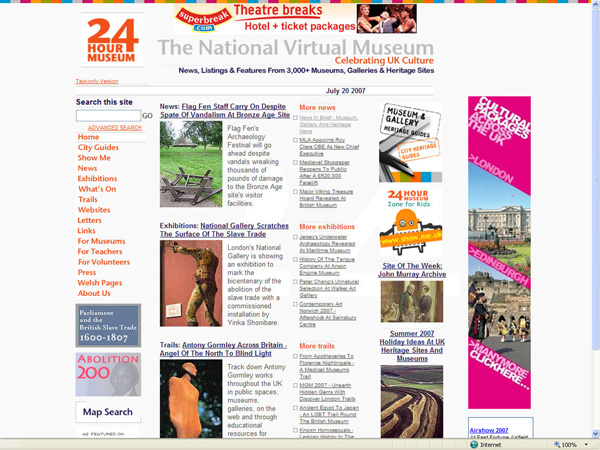
Figure 1: Screenshot of the 24 Hour Museum homepage

Figure 2: How the BBC told the story of the 24 Hour Museum launch in 1999
The cost of the site at launch was around £70,000 and it was projected to cost around £55,000 per year to run. Small beans at today's prices, but in 1999 quite a sum. Interestingly, this was core funding, not project money, a real aid to planning and sustainability.
Launch editor was respected arts writer Simon Tait. Simon collated printed press releases and chose stories in consultation with Ylva French, from the Campaign for Museums (CfM). With Loyd Grossman, Ylva and the CfM were instrumental in getting the site started, together with the Museums Documentation Association (now the MDA) in Cambridge.
Simon's copy was sent to the CfM offices, where it was checked, subbed and forwarded to MDA, which uploaded the content to the Web site. Uploading was accomplished using a Windows-based WIX client working into an SSL Index + CMS [8]. For now, this robust system is still in use. Pictures were researched from the CfM office in London, transparencies then being posted to Cambridge for scanning, editing and uploading by MDA.
By summer 2000 it was clear changes were needed. Jane Finnis, who, as Director of Lighthouse, a media facilities and training centre in Brighton, had radically developed the centre, was recruited to pull the 24HM operation together on one site with newly granted independent status. Interviewed for the job of Editor in December 2000, my pitch involved putting in place journalistic values and the sort of publishing and editorial practices that would get things moving and pull in readers.
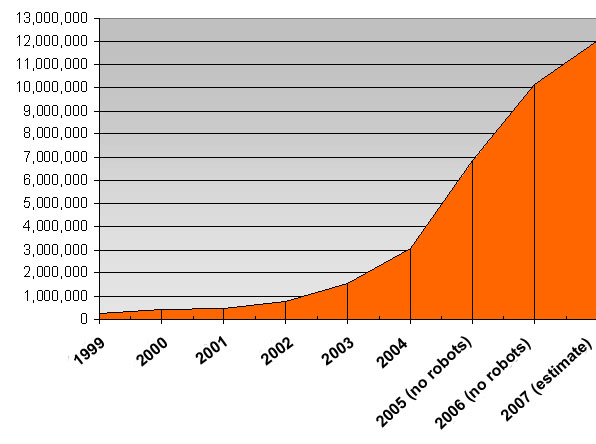
Figure 3: Growth of 24HM visitor sessions 1999-2007
Making Changes, New Technology
First impressions of the Web site in 2001 were interesting. The site updated every two weeks, pictures were few and far between. Visitor figures were on the low side (around 25,000 per month in Jan 2001) after a bright period following the launch fanfare. It seemed search engines were not indexing the site very well.
Importing good publishing practice was the first step: first weekly, then daily updating. Changing the homepage frequently kept people wanting to check the site. Better key wording of articles and titles and more pictures on stories came next [9].
Looking into the search indexing problem, I found the dynamic site needed to be optimised to suit search engines: this led to SSL, our contractors, building pages that signposted our content more effectively to Google. Ariadne readers may remember things called 'Z' pages. We looked into what these were, also asking SSL to make our URLs more 'friendly.' Site visits soon began to grow, doubling each year.
Working at the Daily Telegraph in 1999, I was intrigued to see something new and exciting that added value and meaning to the Web - an RSS aggregator Web site called NewsNow [10]. It pulls together news ticker feeds from multiple sources into one interface. Looking into this further, I found it was enabled by RSS (Really Simple Syndication) XML technology [11].
Wanting to grab some of this connectivity, we put together a rough specification for a feed in early 2003 with SSL. There was a brief moment of worry when those around us were advising the use of RSS 1.0. Looking outwards, major publishing users of RSS were mostly employing RSS 2.0, a slightly different set of standards and technologies. Since the point of RSS was to join our information up with the outside world, not the murky interior of the museum and Further Education sector, we plumped for RSS 2.0 - in our view, exactly the right choice.
Our first RSS feed premiered in summer 2003, resulting in an immediate leap in usage of the site [12]. Subtle in many ways, RSS activity does not usually represent a massive change in visitor numbers; rather it can be a good way to reach influencers like cultural journalists, RSS aggregating sources like Moreover [13], Feedburner [14] and so on. These days it is useful to note the ubiquity of RSS culture - the very simplicity of XML has made it the building block of Web 2.0.
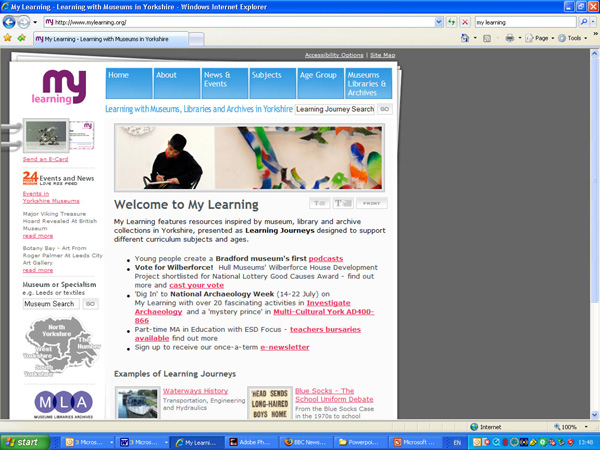
Figure 4: 24 Hour Museum RSS feed seen on My Learning, the Yorkshire Museum's hub education Web site
2003: Extending the Offer: Show Me
Our children's site, Show Me [15] was funded in the build stage by the Clore Duffield Foundation and launched in 2003; another simple journalistic site, driven off the same database and Index + client. This time though, the emphasis was on educationally sound content directly aimed at children at Key Stage 2 of the National Curriculum. Show Me is all about finding great museum content (whether games, resources, things to make and do, etc) writing about it in accessible ways, attracting readers, then brokering the audience out to the source museum Web sites.
Show Me is edited by Anra Kennedy, an experienced teacher, trained journalist and respected expert on museum Web education. Anra has built Show Me into a popular site for children both in school and at home, regularly reaching 300,000 plus visitors (robots excluded) per month.
Weaving Information Threads Together
At the heart of 24HM is a growing database of 3800 museums, galleries, libraries and archives. Each venue can use an online Direct Data Entry (DDE) [16] system to add events, amend venue details, add collection information and educational resources. Well over half of our participants use the system, and the database is a living, breathing fertile information store, used to drive data into all corners of the 24HM family of Web sites, as well as some external ones too.
Of course, in a Web 2.0 context, holding a live and authoritative source of data is a useful commodity, something to be offered to others to use in new digital contexts. DDE is a valuable informational commodity that gives 24HM equity with external publishers, as well as individuals wishing to mash up our data. In this age of shared, exchanged and interwoven data, DDE can be seen as a crucial part of the way we work.
Citizen Journalists and Sustainability
Sustainability is the core characteristic of 24HM content development strategy. Needing more content to update the site more frequently, work experience agreements with journalism courses were put in place from 2001 onwards to build writing capacity organically. We used, and still use, these opportunities to spot good writers, building up layers of structured volunteer placements which then give us a pool of ready-trained people to work with.
As a result, though we can populate the basic site with a small number of writers, we can also expand to fit new opportunities if project money comes in. Volunteers around the country were a natural extension of the in-house effort and they number some 20 at any time: over 120 writers have been published on the site since 2001. Many have gone on to full-time employment as a result.
The Present Day and the Current Rebuild: Success and the Portal Problem
It's a bind - get yourself high up in Google and search-borne visitors pop off elsewhere after looking at just one page. Successful sites have faced this dilemma since the rise of search engines. For the last five years or so, the BBC, The Guardian and other digital media publishers have tackled the fickle one-page visitor by clustering associated content together into sections. Analysis of 24HM audience trends show we face the same situation. The current architecture of 24HM relates to an early Web model of user behaviour, and it clearly fails to serve today's search-borne readers. While we successfully write and deliver up-to-the-minute content into the places online where audiences are to be found, the architecture and navigation of the site cannot deliver more associated content to keep readers on-site.
Thanks to funding from the DfES in late 2006 we began to rethink the shape and philosophy of the site, with a special brief to expand the way the site delivers educational content to audiences. According to David Dawson, head of Digital Futures at MLA, the site needed to be a 'cultural broker': an apt way to describe the way Show Me and 24HM woo audiences with timely and topical journalism, sharing out traffic to linked museum or gallery Web sites, where they can enjoy authoritative content at source. We will also be publishing data sources outwards from our site - we mine our participating venues for events, venue and collection details and these can be available as Web services, API's , RSS or variations on OAI harvesting or SOAP (Simple Object Access Protocol).
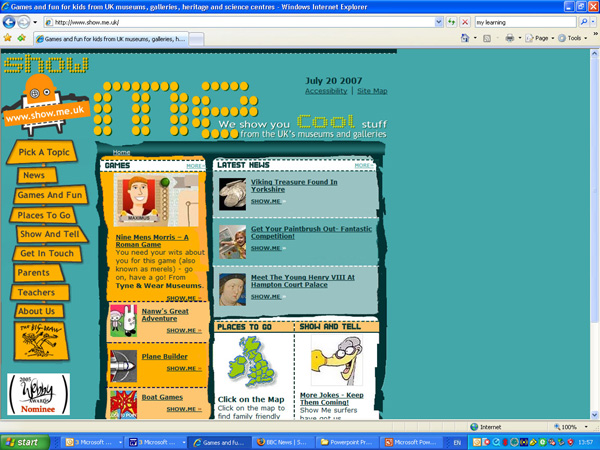
Figure 5: Show Me - 300,000 visits per month to this 24HM KS2 Web site
Beyond the cultural broker idea, the rebuild process is intended to recut existing and new database content into subject-based silos, allowing us new ways to sort and display content of all types in ways that will increase our conversion ratio of page visits to substantial sessions. This being a Web 2.0 world, the new 24HM will make extensive use of taxonomies and vocabularies to sort content automatically where possible; and of course, with the DfES funding in mind, we will be building relationships with the curricula of all four UK nations as well.
Extensive user profiling, sector consultation, brand evaluation and accessibility research has already been carried out, with work going on also to look closely at how the rebuild may benefit others in the sector who may want cost-effective and standardised ways to publish too. As a result, MDA has brought into the project the Subject Specialist Network (SSN) Explore Web sites that are likely to be based on simplified off-the-peg versions of the new 24HM site architecture and CMS.
Nick Poole, Director of MDA, is firmly convinced about the benefits of joined-up thinking in the digital cultural sector. We are all familiar with expensive cultural Web sites that pop up and disappear almost overnight, of repeated re-development of solutions for problems that do not exist, and grandiose schemes for seamlessly inter-operating networks that are neither seamless, interoperable, or even networked.
In his speech to the Museums Computer Group Autumn 2006 meeting at the Natural History Museum, published later on the 24 Hour Museum [17], Poole effectively summarised new ideas for shared architecture, pooled skills and a more strategic approach to knowledge management across the museum and gallery sector.
24 Hour Museum sits at the core of lots of the connected Webs of data joining the creative sector. We try to be the place where audiences find animated, topical and interesting content; the latest events and listings data, and pathways through to many inspiring cultural experiences, in museums, galleries, archives and libraries, amongst others. According to Nick Poole, 24HM is a key marketing layer that can play an effective, popular and sustainable role as part of an intelligent structure melding centrally aggregated and stored cultural information; good practice in standards and infrastructure that could help us all.
This re-consideration of the wider strategic place of 24HM has led to our recasting the rebuild as an Integrated Architecture Project (IAP), with the intention of offering to the rest of the sector a distributed publishing, data-sharing and collaboration platform.
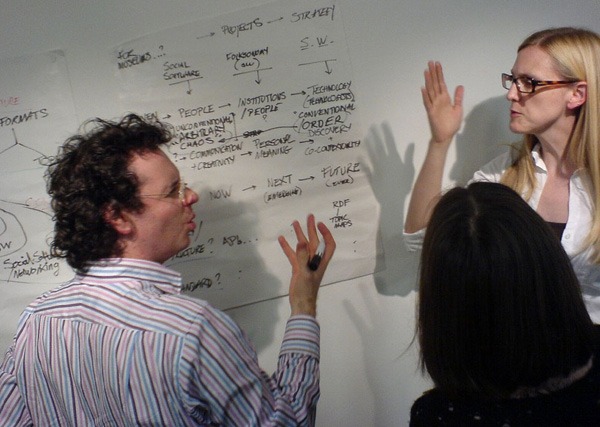
Figure 6: Ross Parry, University of Leicester, discusses the meaning of the Web with Frances Lloyd Baynes, V&A, London, at a Semantic Web Think Tank meeting in Brighton
The Semantic Web Think Tank
In the perfectly interoperable future, better metadata might connect all our material more closely, more intelligently, and with more meaning. It is this opportunity for more thoughtful connection that lead to our recent Semantic Web Think Tank (SWTT) Project [18], a radical experimental partnership between 24 Hour Museum, the Museums Computer Group [19], MDA, national museums and many collaborators in the academic world as well as the software sector.
24 Hour Museum was keen to participate in the AHRC-funded partnership project to help us inform our rebuild effort. The £15,000 project pulled together small groups of experts to talk in directed sessions, which would then be recorded and published as short papers or notes.
The six meetings that followed were planned in advance to deal with likely developmental themes pre-agreed by a core organising group. SWTT was funded to be a think tank, and initially intended not to make product, but to look for directions, to sense the lie of the land for us and to perhaps make some simple recommendations for those who have responsibility for the development of cultural digital infrastructure in the UK.
The major benefit from the SWTT Project has not, in the end, been a demonstrator or widget of some kind. It is instead the emergence of a suggested roadmap for the future development of a joined-up digital cultural sector, which will be revealed in more detail in a report published late 2007/spring 2008.
If we have any notion of wanting to develop a knowledge web we need to consider the bindings, the threads that weave together to make one. SWTT will work over the next year to advocate more thought, communication and co-ordination between the arts, tourism and museum and gallery sector with respect to taxonomical systems, vocabularies, tagging systems and database relationships. Simple first steps in this new effort might be to see more formal taxonomical connections between systems we are already working on, like the SSN Explore Web sites.
Conclusion
In seven years 24 Hour Museum has become established as a key player in the digital cultural sector in the UK. We work to support regional initiatives through linking efforts, we power Web sites for Museums and Galleries Month, Abolition 200 and Untold London and we have put together data-sharing partnerships across boundaries, with bodies like Visit Britain, The Art Fund and Arts Council England.
As the Web joins up more, as we inch towards a more meaningfully connected digital world, 24 Hour Museum's place in the cultural infrastructure is clearly vitally important. With the Cultural Olympiad racing up to meet us in September 2008, and 2012 looming large in our exhibition programming diaries, we need a joined-up digital cultural sector which gets our great British culture and heritage out there onto the World Wide Web quickly, efficiently and in a sustainable fashion.
With 2012 in mind, 24 Hour Museum strategy is to keep looking outwards for great new technologies that could help us all weave that better Web; to look creatively at ways we can cleverly join up our common digital interests and to support sensitively with assistive infrastructure the excellent digital cultural work going on all over the UK. One thing is certain: the way to a better future Web is through better connections - semantically, politically and creatively.
Editor's note: Following the publication of this article in the Summer Issue, 2007, the organisation that publishes 24 Hour Museum changed its name to Culture24 on 26 November 2007 [20] [2008-01-16].
References
- The 24 Hour Museum Web site http://www.24hourmuseum.org.uk
- 'Riding the new wave web', Jon Pratty, January 2007, 24 Hour Museum Web site http://www.24hourmuseum.org.uk/nwh_gfx_en/ART42348.html
- 'Are museums doing IT right?' Nick Poole, December 2006, 24 Hour Museum Web site http://www.24hourmuseum.org.uk/nwh/ART41939.html
- The Museum Documentation Association (MDA) http://www.mda.org.uk/
- '24 Hour Museum goes live', 13 May 1999, BBC Web site http://news.bbc.co.uk/1/hi/sci/tech/342954.stm
- '24 Hour Museum prepares to go live,' 18 January 1999, BBC Web site http://news.bbc.co.uk/1/hi/education/specials/bett_99/254933.stm
- Culture Online, London http://www.culture.gov.uk
- SSL Limited, London http://www.ssl.co.uk/
- Communications with nobody: is anybody out there? conference paper, CULT 2001, Copenhagen, 2001 http://cult.kulturnet.dk/pt3.htm
- NewsNow Web site http://www.newsnow.co.uk/
- 'RSS,' Wikipedia entry, retrieved 5 August 2007 http://en.wikipedia.org/w/index.php?title=RSS&oldid=145740751
- The 24 Hour Museum RSS newsfeed, conference paper, Museums and the Web 2004 http://www.archimuse.com/mw2004/papers/pratty/pratty.html
- Moreover Web site http://w.moreover.com/
- Feedburner Web site http://www.feedburner.com/
- Show Me Web site http://www.show.me.uk/
- 'How to use our Database,' 24 Hour Museum Web site http://www.24hourmuseum.org.uk/etc/formuseums/TXT17733_gfx_en.html
- 'Are museums doing IT right?' Nick Poole, December 2006, http://www.24hourmuseum.org.uk/nwh/ART41939.html
- UK Museums and the Semantic Web Web site http://culturalsemanticweb.wordpress.com/
- The Museums Computer Group http://www.museumscomputergroup.org.uk/
- 24 Hour Museum to Become Culture24!, 24 Hour Museum, 27 November 2007 http://www.24hourmuseum.org.uk/etc/about/TXT52252_gfx_en.html
Author Details
Jon Pratty is a Fine Art graduate and has worked in the museum and gallery sector for 15 years, as well as serving time in design consultancy in London in the 90's. He retrained as a journalist over 1996-7 and made a name in technology and Web writing, working in the Daily Telegraph's 'Connected' section, as well as 'Doors', on the Sunday Times.
